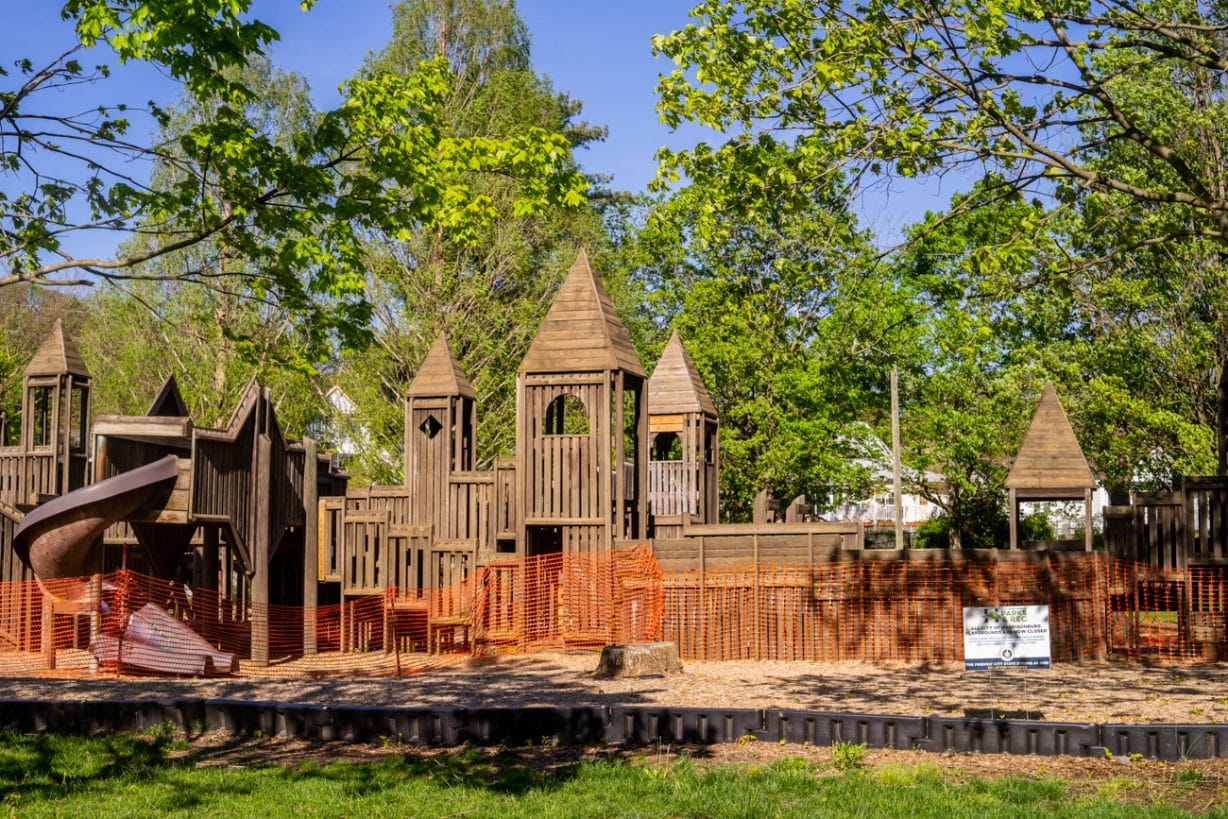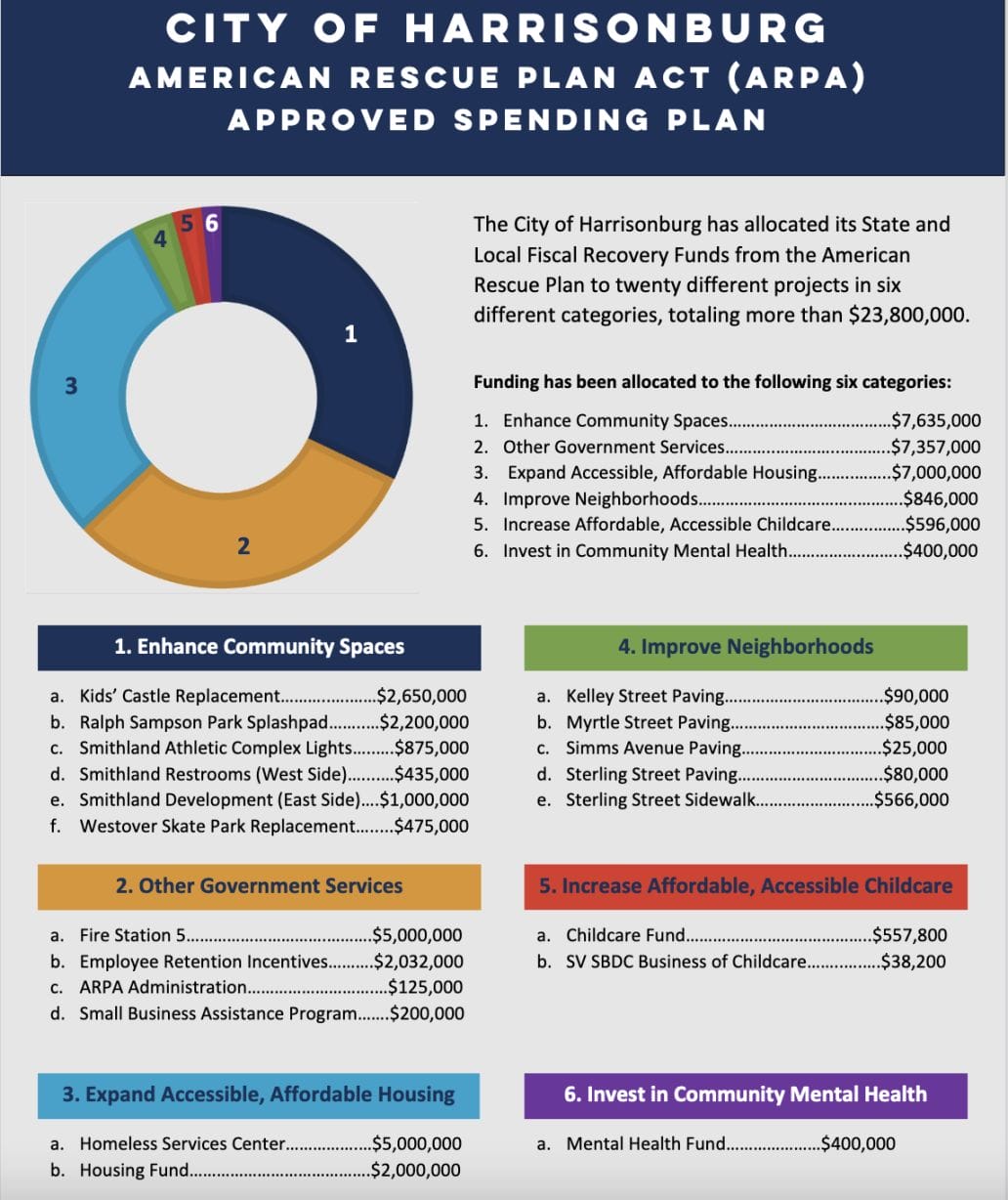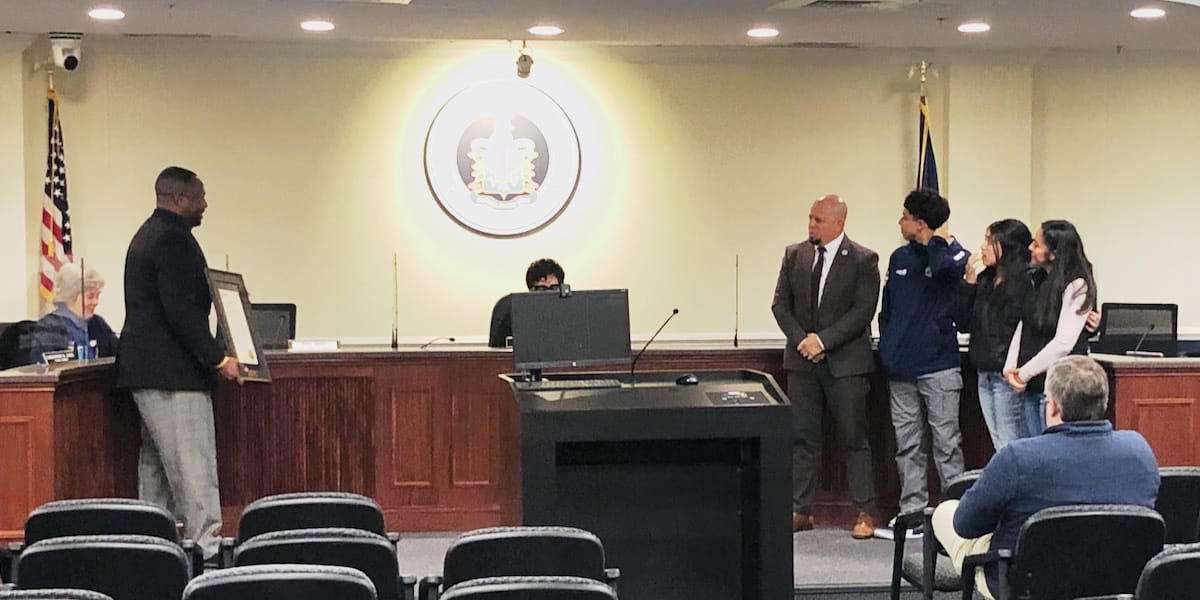
Correction: An earlier version of the story contained the wrong photo and reference to the location of Kids Castle. The Kids Castle is in Purcell Park. And the updated version of the story also includes a graphic with the updated spending.
By Ryan Alessi, publisher
The Harrisonburg City Council on Tuesday put a bow on its plan for spending more than $20 million in federal funds, while Vice Mayor Sal Romero wrapped up the last meeting of his four-year tenure.
The four sitting council members — who weathered the bulk of the COVID-19 pandemic together – held a rare meeting during the final week of a calendar year specifically so that they could finish the allotment of American Rescue Plan Act funds. Congress passed that measure in 2021, which included money to help communities recover from the effects of the pandemic.
Harrisonburg’s share worked out to be $22.9 million, which the council decided at the Dec. 13 meeting to spend on a mix of projects, including about $7 million for improvements and repairs to the city’s parks.
“I wanted to use this money to reach as many projects as we can do. And I felt that we did that,” Mayor Deanna Reed said Tuesday just before the council voted 3-1 for the plan’s final approval. “It’s a diverse list, and we’re touching everything that we possibly can touch.”
The council had previously slated $5 million for the construction of the new fire station in northwest part of the city near EMU. In addition, about $5 million is going toward the construction of a permanent low-barrier shelter for people experiencing homelessness. And the city used $700,000 to purchase land on North Main Street where the shelter and a Homeless Services Center will be.
The final spending plan for the ARPA funds also includes:
- $2.65 million for the Kids Castle at Purcell Park playground
- $2.2 million for Ralph Sampson Park improvements
- $2 million for a housing assistance trust fund
- $1 million for Smithland Development
- $875,000 for lights at the Smithland Athletic Complex and another $435,000 for the restrooms at Smithland
- $566,000 for sidewalks on Sterling Street and another $80,000 for street paving
- $475,000 for the Westover Skate Park

The mix of funds bothered council member Laura Dent, who said she wanted to see more money go toward funds to support childcare, mental health and efforts to help people experiencing homelessness and low-income residents find sustained housing.
“I’ll just reiterate briefly the same reason I gave for voting against it before — that I can’t in conscience support the spending plan that puts more in recreation than housing, childcare and mental health combined,” she said in defending her vote against it. She also opposed the spending plan at its first reading at the Dec. 13 meeting.
The others pushed back against that. Council member Chris Jones said when adding the cost of the homeless shelter and the housing assistance fund, the city has invested as much. And both Jones and Romero said investing in parks and recreation will pay long-term dividends and is inclusive because everybody in the city can use and enjoy the parks — their playgrounds, athletic fields, walking paths, pavilions and greenspaces.
Romero said part of what drove his decision about spending money was conversations with “people that I see and talk with … who are never going to come to this meeting.”
“Sure, we could have done some other things. But at the end of the day, we were limited by the funding that we had,” Romero said. “In my viewpoint it wouldn’t make any sense at this point to undo what we promised we said we were going to do.”
The city also embarked on a nearly year-long process to gather community feedback through surveys and public meetings about how to spend the ARPA funds. Reed, Romero, Jones, Dent and George Hirschmann, who resigned from the council in May for health reasons, also debated different approaches and potential spending priorities at council meetings over the last year.
In addition to targeting several different areas, including improvements to the Northeast Neighborhood and the construction of a new fire station, Reed said the process for soliciting input also helped confirm for her that the council made the best decisions.
“I talked to other localities. They didn’t do it like that,” she said. “They did a couple of big projects and that’s it. They didn’t talk to the community.”

Romero honored
For Romero, Tuesday’s meeting was the last of his four-year term. He opted not to seek re-election this year.
And Reed started the meeting with a resolution honoring him while Romero’s wife, Maria Cardoso, as well as their daughter Jaqueline and son Daniel, looked on from the audience.
Romero’s service to the city could be summarized with the words “integrity, fairness and effectiveness,” the resolution said.
The resolution also praised Romero for his broad participation in civic groups and boards during his four years on the council, as well as the issues he helped champion, such as approving construction of the new Rocktown High School and translation services for city services and meetings.
“Sal was committed to protecting the health and wellness of people in our community during the pandemic, especially those who do not speak English,” Reed said, quoting from the resolution.
Romero told the council he’d be happy to provide advice or assistance — an offer Reed said the council will be taking him up on.
“I wish the next council the best of luck,” Romero said.
Editor’s note: The Citizen will publish on Wednesday a piece about Romero’s experience on the council, including his views on what it meant to be the first Latino elected to the council and what it was like to serve as a local government leader during a global pandemic.
New council meets Jan. 3
The council will next meet at 10 a.m. Jan. 3 for its organizational session, during which the newly elected city council members, Monica Robinson and Dany Fleming, will be sworn in and join Reed, Jones and Dent in selecting the next mayor and vice mayor from among their ranks, in addition to other organizational decisions.
Journalism is changing, and that’s why The Citizen is here. We’re independent. We’re local. We pay our contributors, and the money you give goes directly to the reporting. No overhead. No printing costs. Just facts, stories and context. We’re also a proud member of the Virginia Press Association. Thanks for your support.














